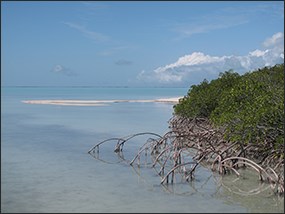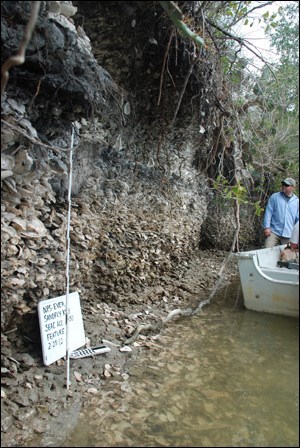
NPS photo In addition to effects of sea-level rise in Cape Sable and the saline glades, changes also exist outside of Everglades National Park. Northwest of Everglades National Park in the Ten Thousand Islands National Wildlife Refuge, mangroves have expanded and grown inland into what were previously freshwater environments9. And in the southernmost Florida Keys, freshwater pine forests are shrinking and are being replaced by plants that live in saltwater10. In both cases, plants are responding to the conversion from freshwater to saltwater environments because of sea-level rise9,10. These observed changes are important because they show that the consequences of sea-level rise are occurring throughout south Florida and may indicate what these coastal habitats will be like in the future. From these changes, already observed, scientists may learn how to best manage our coastal ecosystems over the long term. 
NPS Photo Sandfly Island in the Ten Thousand Islands Archeological District of Everglades National Park is an important cultural site currently impacted by climate change. It consists of 22 acres of prehistoric networks of earth and shell mounds – or middens – that are about 3,000 years old11. Water erosion and wind damage over the years have made parts of the Sandfly Island shoreline and its tidal creek banks collapse, further exposing the fragile archaeological site to sea-level rise and increased salinity, which can harm the artifacts. These sites allow scientists to examine human history, but the artifacts may be less useful in the future if they are washed away or too damaged to analyze.
In 2012, using a high-resolution 3D laser-scanner, scientists were able to collect data such as artifact locations and shell orientations from the eroded Sandfly Island banks. These data can show how many and what types of artifacts exist now and can then be compared to data collected in the future11. The park would likely benefit from information like this for the hundreds of other cultural sites that exist. However, the challenge for cultural resource managers is to balance the acquisition of additional site inventories with working to protect known cultural resources.
NEXT PAGE >> The Climate Change Response Strategy How Are The Saline Glades Changing? << PREVIOUS PAGE |
Last updated: September 9, 2015

